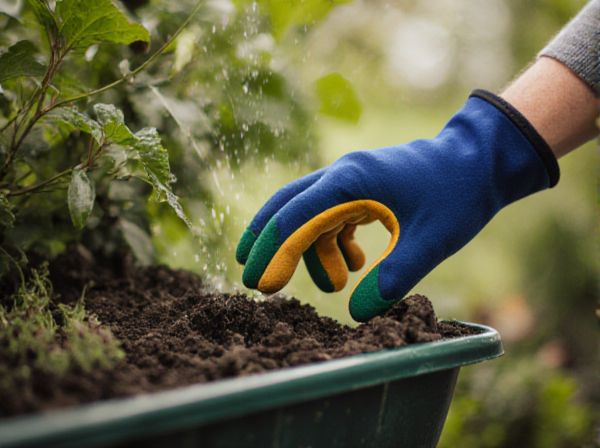
Bottom Heating vs Overhead Heating Illustration
Bottom heating in greenhouses provides consistent warmth directly to plant roots, promoting faster germination and stronger root development. Overhead heating distributes warm air throughout the greenhouse, ensuring even temperature control and reducing cold spots around the canopy. Choosing between bottom and overhead heating depends on crop type, energy efficiency, and specific growth requirements.
Table of Comparison
| Feature | Bottom Heating | Overhead Heating |
|---|---|---|
| Heat Source Location | Under the soil or plant trays | Above plants, usually installed on ceiling or walls |
| Heat Distribution | Direct soil warming; promotes root growth | Air heating; warms entire greenhouse volume |
| Energy Efficiency | Higher efficiency due to direct soil heating | Less efficient, heat rises and escapes faster |
| Plant Benefits | Improves seed germination and root development | Maintains overall air temperature; can prevent frost |
| Installation Complexity | Requires soil or bench installation; moderate effort | Easy to install on existing structures |
| Cost | Higher upfront cost; lower operational cost | Lower installation cost; potentially higher energy use |
| Best Use Cases | Seedlings, root-sensitive plants, propagation benches | Larger greenhouse volumes; general air temperature control |
Introduction to Greenhouse Heating Methods
Bottom heating in greenhouses involves warming the soil to promote root development and enhance plant growth, often using heated mats or soil cables. Overhead heating distributes warmth through fans or radiant heaters suspended above plants, maintaining ambient air temperature to protect foliage from cold stress. Choosing between bottom and overhead heating depends on crop type, energy efficiency, and greenhouse design requirements.
What is Bottom Heating in Greenhouses?
Bottom heating in greenhouses involves applying warmth directly to the root zone of plants by using heated mats, cables, or radiant heating systems installed beneath seed trays or growing beds. This method promotes faster germination, improved root development, and enhanced nutrient uptake by maintaining an optimal soil temperature typically between 70degF and 85degF. Unlike overhead heating, bottom heating targets soil warmth precisely, reducing energy consumption and minimizing airflow disruption inside the greenhouse environment.
Understanding Overhead Heating Systems
Overhead heating systems in greenhouses distribute warm air uniformly from the ceiling, promoting consistent temperature regulation and reducing cold spots that can hinder plant growth. These systems often utilize suspended heaters or warm air ducts, which improve air circulation and prevent heat stratification, essential for optimal crop development. Implementing overhead heating supports energy efficiency and enhances the microclimate, resulting in healthier plants and higher yields.
Efficiency Comparison: Bottom vs Overhead Heating
Bottom heating in greenhouses delivers warmth directly to plant roots, enhancing energy efficiency by minimizing heat loss and promoting faster growth cycles, while overhead heating tends to waste energy by warming the air above plants, increasing heat stratification. Studies show bottom heating systems can reduce energy consumption by up to 30% compared to traditional overhead systems, optimizing thermal distribution and maintaining stable root zone temperatures essential for plant health. The targeted approach of bottom heating improves overall greenhouse climate control, resulting in lower operational costs and improved crop yields.
Impact on Plant Growth and Health
Bottom heating in greenhouses promotes root development by providing consistent warmth directly to the soil, which accelerates seed germination and enhances nutrient uptake. Overhead heating tends to create uneven temperature distribution, potentially causing moisture evaporation on leaves and increasing the risk of fungal diseases. Optimizing heating methods by focusing on root zone warmth improves overall plant health, growth rate, and yield quality in controlled environments.
Installation and Maintenance Requirements
Bottom heating systems in greenhouses require installation of under-bench or in-floor heating elements, demanding significant initial groundwork but offering uniform root zone warmth with less frequent maintenance. Overhead heating units are easier to install, typically mounted on ceiling or walls, but they may necessitate regular cleaning and filter replacement to maintain efficiency and air quality. Both systems differ in complexity and upkeep, with bottom heating favoring longer-term reliability and overhead heating providing flexible, accessible heat delivery.
Energy Consumption and Cost Analysis
Bottom heating in greenhouses typically consumes less energy than overhead heating due to direct soil warming, promoting efficient root growth and reducing heat loss. Overhead heating requires higher energy input to maintain optimal air temperature, leading to increased operational costs. Cost analysis reveals bottom heating systems offer long-term savings through reduced fuel and electricity usage despite higher initial installation expenses.
Suitability for Different Crops and Seasons
Bottom heating in greenhouses provides consistent root zone warmth ideal for seedlings, root vegetables, and heat-loving crops during cooler seasons, enhancing germination and early growth. Overhead heating distributes warm air throughout the canopy, benefiting taller crops like tomatoes and peppers that require uniform air temperature during colder months. Crop selection and seasonal conditions dictate the choice, with bottom heating preferred for young plants and overhead heating suited for mature crops needing ambient warmth.
Pros and Cons of Bottom Heating Systems
Bottom heating systems in greenhouses provide consistent root zone warmth, promoting faster seed germination and stronger plant growth by maintaining optimal soil temperatures. They offer energy efficiency by targeting heat where plants need it most, reducing heat loss compared to overhead systems. However, bottom heating can be limited by uneven heat distribution in larger greenhouses and may require more complex installation and maintenance to prevent root zone overheating or moisture issues.
Advantages and Drawbacks of Overhead Heating
Overhead heating in greenhouses offers uniform heat distribution by radiating warmth from above, reducing soil-borne diseases and promoting even plant growth. However, it can lead to higher energy consumption and heat loss compared to bottom heating, especially in poorly insulated structures. Another drawback includes potential leaf scorching if temperatures are not carefully monitored and controlled.
Bottom Heating vs Overhead Heating Infographic

 gardendif.com
gardendif.com